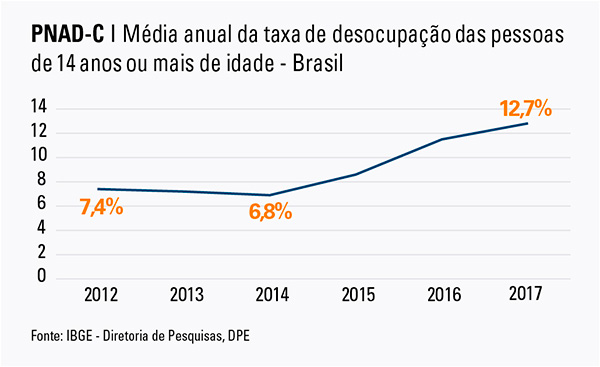Unemployment retreats in December, yet average rate in the year is the highest since 2012
January 31, 2018 09h00 AM | Last Updated: January 31, 2018 12h03 PM
In spite of the drop in the unemployment rate from 12.4% to 11.8% between the third and fourth quarters, 2017 was the worst year for the labor market in Brazil since 2012. Having registered an average rate of 12.7%, unemployment hit the highest level in the time series. The difference was 5.9 p.p. in relation to 2014, when the average unemployment rate reached its lowest level (6.8%). These data are from the Continuous National Household Sample Survey - PNADC, released today by the IBGE.

Nearly 6.5 million more unemployed persons were recorded between 2014 and 2017, a growth of 96.2%, reaching 13.2 million persons. Cimar Azeredo, IBGE coordinator of Labor and Income, explained that Brazil lost many job positions over the last three years, particularly the formal ones. "The number of workers with a formal contract, which had been 36.6 million in 2014, now stayed at 33.3 million. In three years, we lost 3.3 million job positions with a formal contract". In relation to 2016, the drop in the number of workers with a formal contract was of nearly one million persons.
Between 2016 and 2017, the number of workers in the private sector without a formal contract rose 5.5%, which represents 560 thousand workers. The average increase was of 3.2% over 2014, or 330 thousand persons. The number of self-employed workers rose 0.7% in the last year, a contingent of 159 thousand persons. The increase was of 6.5% or 1.3 million workers in this category in three years.
Groups of significant activities, like agriculture, industry and construction, were those that mostly lost workers. “In these three years, the drop in agriculture was of 10.4%, in industry, -11.5% and, in construction, -12.3%. Part of these positions were offset in groups that have a more informal insertion process, like trade, other services and housing and food", explained Cimar.
The results confirm that trade increased the number of workers by 0.5%, other services, by 7.0% and housing and food, by 21.4% in relation to 2014. According to Cimar, this happens because food services work like a escape valve during periods of downturn. "You can refrain from buying, traveling and refurbishing your house, yet you have always to eat. That is why unemployed persons move to this sector, where the opportunities are", explained him.
The annual average earnings of workers stayed at R$2,141 in 2017, a rise of 2.4% in relation to 2016. Nevertheless, the picture remained stable in relation to 2014, when the highest earnings were registered in the time series.
"Besides the low inflation recorded in 2017, the exit of persons with lower earnings should rise the average earnings. As the population with higher earnings dropped as well, the earnings in 2017 remained at the same level as in 2014", concluded Cimar.




















